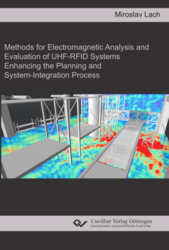| Areas | |
|---|---|
| Serie de libros (96) |
1379
|
| Nachhaltigkeit |
3
|
| Gesundheitswesen |
1
|
| Letra |
2367
|
| Ciencias Naturales |
5407
|
| Ciencias Ingeniería |
1793
|
| Ingeniería | 292 |
| Ingeniería mecánica y de proceso | 862 |
| Ingeniería eléctrica | 686 |
| Mineria y metalurgía | 30 |
| Arquitectura e ingeniería civil | 75 |
| General |
98
|
|
Leitlinien Unfallchirurgie
5. Auflage bestellen |
|
Erweiterte Suche
Methods for Electromagnetic Analysis and Evaluation of UHF-RFID Systems (Tienda española)
Enhancing the Planning and System-Integration Process
Miroslav Lach (Autor)Previo
Indice, PDF (36 KB)
Lectura de prueba, PDF (70 KB)
This work focuses on methods for electromagnetic analysis and performance evaluation of UHF-RFID systems to enhance the planning and system integration process. This includes the analysis of performance degrading effects occurring in close proximity to RFID transponders, as well as the assessment of the large-scale signal coverage in harsh operational environments. Shortcomings of state-of-the-art methods are investigated and novel evaluation techniques based on accurate full-wave analysis are proposed. In addition, innovative approaches for determining the interference effects in the near-field using artificial neural networks are investigated, and drone-based systems for autonomous measurements of large-scale signal coverage are researched to validate the newly developed assessment methods. Finally, recommendations for action are provided in the form of a general framework proposing suitable simulation methods and evaluation schemes considering the analyzed operational environment and its different planning phases.
Methoden zur elektromagnetischen Analyse und Bewertung von UHF-RFID-Systemen zur Verbesserung des Planungs- und Systemintegrationsprozesses
Diese Arbeit befasst sich mit Methoden zur elektromagnetischen Analyse und Leistungsbewertung von UHF-RFID-Systemen, mit dem Ziel, den Planungs- und Systemintegrationsprozess zu verbessern. Dies umfasst die Analyse von beeinträchtigenden Effekten in unmittelbarer Nähe von RFID-Transpondern, sowie die Bewertung der großflächigen Signalabdeckung in komplexen Betriebsumgebungen. Die Unzulänglichkeiten aktueller Methoden werden untersucht und neue Bewertungsvorgehen basierend auf hochgenauen Vollwellen-Analysen präsentiert. Zudem werden innovative Ansätze zur Bestimmung der Interferenzeffekte im Nahfeld mithilfe von künstlichen neuronalen Netzen untersucht, sowie drohnenbasierte Systeme zur autonomen Vermessung von großflächigen Signalabdeckungen erforscht, um die vorgeschlagenen Bewertungsmethoden zu validieren. Abschließend werden Handlungsempfehlungen in Form eines Frameworks bereitgestellt, um passende Simulationsmethoden und Auswerteschemata unter Berücksichtigung der zu untersuchenden Einsatzumgebung in verschiedenen Planungsphasen vorzuschlagen.
| ISBN-13 (Impresion) | 9783736979550 |
| Formato | A5 |
| Idioma | Inglés |
| Numero de paginas | 170 |
| Laminacion de la cubierta | mate |
| Edicion | 1. |
| Lugar de publicacion | Göttingen |
| Lugar de la disertacion | München |
| Fecha de publicacion | 07.02.2024 |
| Clasificacion simple | Tesis doctoral |
| Area |
Ingeniería eléctrica
|
| Palabras claves | Radio-Frequency Identification, RFID, UHF-RFID, RAIN RFID, Industry 4.0, Internet of Things, Artificial Intelligence, Machine Learning, Cyber-Physical Systems, Automation, Auto-ID, Factory Planning, Digital Twin, Planning Processes, Drones, UAV, Field-Mapping, CEM, Computational Electromagnetics, Electromagnetic Simulation, Indoor Wave Propagation, Field-Probing, Signal Interference, Overreach Areas, Dead-Zones, Backscatter Communication, Electromagnetic Analysis, RFID-Transponder, Near-Field Detuning, Readability, Reliability Evaluation, Signal Coverage Prediction, Deterministic Simulation, Empirical Computation, Full-Wave Simulation, Production Planning, Finite Integration Technique, Geometrical Optics, Physical Optics, Finite Element Method, Tag Readability Rating, Polarization, Operational Environment Planning, Large-Scale Interference Analysis, wireless communication systems Radio-Frequency Identification, RFID, UHF-RFID, RAIN RFID, Industrie 4.0, Internet der Dinge, Künstliche Intelligenz, Maschinelles Lernen, Cyber-Physische Systeme, Automatisierung, Auto-ID, Fabrikplanung, Digitaler Zwilling, Planungsprozesse, Drohnen, UAV, Feldmessungen, CEM, Computational Electromagnetics, Elektromagnetische Simulation, Wellenausbreitung in Innenräumen, Feldmessungen, Signalinterferenzen, Überreichweiten, Leselöcher, Backscatter-Kommunikation, Elektromagnetische Analyse, RFID-Transponder, Nahfeldverstimmung, Lesbarkeit, Zuverlässigkeitsbewertung, Signalabdeckungsvorhersage, Deterministische Simulation, Empirische Berechnung, Vollwellensimulation, Produktionsplanung, Finite Integrationstechnik, Geometrische Optik, Physikalische Optik, Finite-Elemente-Methode, Tag-Lesbarkeitsbewertung, Polarisation, Planung der Betriebsumgebung, Großflächige Interferenzanalyse, drahtlose Kommunikationssysteme |








